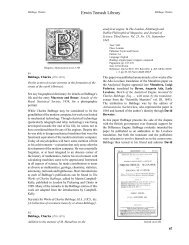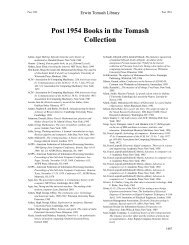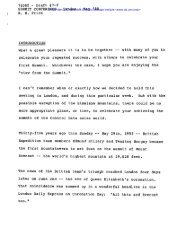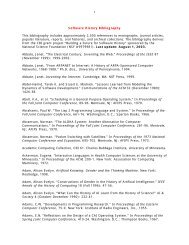M chapter.indd - Charles Babbage Institute
M chapter.indd - Charles Babbage Institute
M chapter.indd - Charles Babbage Institute
Create successful ePaper yourself
Turn your PDF publications into a flip-book with our unique Google optimized e-Paper software.
828<br />
Erwin Tomash Library<br />
Macmillan, Robert Hugh Macrosty, Henry William<br />
This work is a detailed description of the practical<br />
challenges facing a navigator. In particular, it discusses<br />
various instruments and their defects. It also covers<br />
determining longitude by taking observations of either the<br />
Moon or the eclipses of Jupiter’s satellites. The second<br />
volume contains tables, many of which are repeated in<br />
Mackay’s other works (e.g., The complete navigator or<br />
A collection of mathematical tables). The frontispiece is<br />
a portrait of the author.<br />
The fact that this work, including the tables, is printed<br />
on light green paper causes one to wonder if <strong>Charles</strong><br />
<strong>Babbage</strong>, who also experimented with printing tables<br />
on colored paper (see <strong>Babbage</strong>, <strong>Charles</strong>; Table of<br />
logarithms, 1831), might have obtained the idea from<br />
Mackay. The Crawford Library catalog (Copeland,<br />
Ralph; The catalogue of the Crawford library of the Royal<br />
Observatory Edinburgh, 1890), the current location of<br />
<strong>Babbage</strong>’s book collection, shows that <strong>Babbage</strong> owned<br />
other Mackay volumes but not this one.<br />
Illustrations available:<br />
Title page (color showing light green paper)<br />
Frontispiece portrait<br />
M 15<br />
Macmillan, Robert Hugh<br />
M 14<br />
An introduction to the theory of control in mechanical<br />
engineering<br />
Year: 1951<br />
Place: Cambridge<br />
Publisher: Cambridge University Press<br />
Edition: 1st<br />
Language: English<br />
Figures: 1 large folding plate<br />
Binding: original cloth boards<br />
Pagination: pp. xiv, 196<br />
Collation: π 7 1–11 8 12 10<br />
Size: 265x176 mm<br />
Macmillan was a demonstrator in the Engineering<br />
Department of Cambridge University and immediately<br />
prior to writing this book had been a visitor at MIT for<br />
a year.<br />
As the experience with control systems grew, mainly as<br />
a result of World War II, analysis of them in a theoretical<br />
context was not far behind. This volume is one of<br />
many (see, for example, MacColl, LeRoy Archibald;<br />
Fundamental theory of servomechanisms, 1945) that were<br />
published in the immediate postwar period. This work is<br />
notable for including an analysis of the torque amplifier<br />
invented by Vannevar Bush for use on the Differential<br />
Analyzer. Part of the discussion is a question that<br />
appeared on the 1936 final examination in engineering<br />
(Mechanical Science Tripos). Maurice Wilkes (Memoirs<br />
of a computer pioneer, 1985) mentions that his interest<br />
in differential analyzers was first aroused early in that<br />
same year when he attended a lecture and demonstration<br />
in the Mechanical Engineering Department.<br />
Illustrations available:<br />
Title page<br />
Exam question<br />
M 16<br />
Macrosty, Henry William (1865–1941) and James<br />
Bonar (1852–1941)<br />
Annals of the Royal Statistical Society. 1834-1934<br />
Year: 1934<br />
M 15







